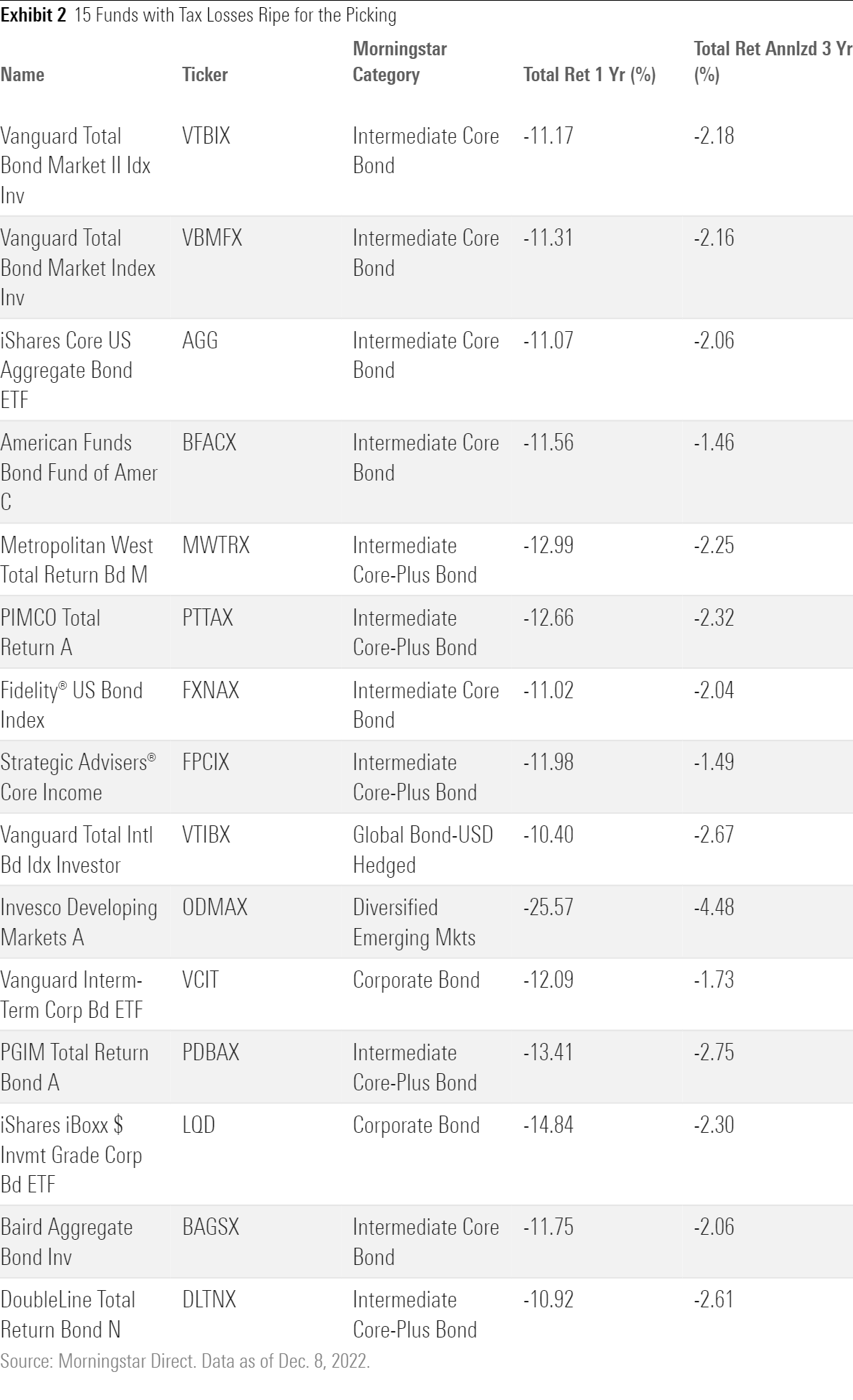Why There Are More Opportunities for Tax-Loss Harvesting in 2022
This year’s brutal market has a silver lining for tax planning.

It’s been a tough market in 2022. Although stocks briefly rallied in October and November, stocks are down about 17% for the year to date through Dec. 8, 2022, and broad bond-market indexes have lost about 11% over the same period. More-speculative areas, such as technology stocks and tech-heavy growth funds, have fared even worse.
The silver lining: Investors have many more opportunities for tax-loss harvesting than usual.
In this article, I’ll highlight some of the most widely held stocks and funds that have declined in price over the past couple of years. I’ll also give some practical guidance for selling securities to realize losses.
Is Tax-Loss Harvesting Really Worth It?
Admittedly, the benefits of tax-loss selling can be overhyped. As Michael Kitces points out, an investor who sells a security in a taxable account and replaces it with another one is simply trading in current taxes for future taxes, because the cost basis on the new holding is lower. Still, the value of deferring taxes can be significant. That’s especially true in an environment when many securities have posted double-digit losses, as they have over the past 12 months.
Stock Ideas for Tax-Loss Harvesting
Opportunities for harvesting losses on individual stocks abound. Roughly 60% of the 1,000 biggest U.S.-traded stocks in Morningstar’s database have suffered price declines over the trailing one-year period, and many of those have also posted losses over the trailing three-year period. The table below shows some of the most widely held stocks that might be good candidates for tax-loss selling. (Note: Investors will need to check their account statements and cost basis as shown on the brokerage platform’s website to confirm declines for any specific positions; they should also make sure they’ve owned the security for at least one year if they intend to realize long-term losses.)

Fund Ideas for Tax-Loss Harvesting
Numerous mutual funds and exchange-traded funds have also accumulated losses over the trailing one- and three-year periods. As shown in the table below, 2022′s terrible bond market has taken a toll on bond funds, many of which now have accumulated losses over the past couple of years.
These losses are a great opportunity for tax-loss harvesting, but I wouldn’t sell out of bond holdings altogether. As I’ve written previously, the worst pain in the bond market is probably behind us. While bonds could continue suffering if the Federal Reserve continues to aggressively hike interest rates to get inflation under control, they now offer more generous yields, which should help cushion losses to some extent. Investors who harvest losses from fixed-income holdings will probably want to replace them (with similar but not substantially identical funds) to maintain their intended asset allocation.

Tax-Loss Harvesting Reminders
There are a few things to keep in mind when selling securities to take advantage of losses in a taxable account. To avoid running afoul of wash-sale rules, make sure to avoid selling securities at a loss and then buying substantially identical securities within 30 days either before or after the sale.
The IRS has not published guidance as to exactly what qualifies as “substantially identical,” but it’s probably safest to replace fund holdings with a vehicle that tracks a different index. For example, an investor selling Vanguard 500 Index VFIAX, which tracks the S&P 500, could replace it with Vanguard Total Stock Market Index VTSAX, which tracks the broader CRSP Total Market Index. On the stock side, investors would want to avoid replacing a stock with another share class of the same stock, but they could replace it with another company in the same industry (such as replacing Budweiser Brewing Co APAC Ltd ADR BDWBY with Boston Beer Co Inc Class A SAM).
It’s also important to maintain good records. Before selling a stock, investors will need to identify specific lots with the highest cost basis. For funds, it’s best to use the specific share identification method, which you can select in your brokerage platform’s account options. (The default method is usually average cost, which doesn’t optimize tax losses.)
Finally, use tax losses strategically. Investors can use harvested tax losses to offset any realized gains or up to $3,000 in ordinary income for the current tax year, but can also carry them forward indefinitely to offset future capital gains.
The author or authors own shares in one or more securities mentioned in this article. Find out about Morningstar’s editorial policies.

/s3.amazonaws.com/arc-authors/morningstar/360a595b-3706-41f3-862d-b9d4d069160e.jpg)
/cloudfront-us-east-1.images.arcpublishing.com/morningstar/IFAOVZCBUJCJHLXW37DPSNOCHM.png)
/cloudfront-us-east-1.images.arcpublishing.com/morningstar/JNGGL2QVKFA43PRVR44O6RYGEM.png)
/cloudfront-us-east-1.images.arcpublishing.com/morningstar/GQNJPRNPINBIJGIQBSKECS3VNQ.jpg)
:quality(80)/s3.amazonaws.com/arc-authors/morningstar/360a595b-3706-41f3-862d-b9d4d069160e.jpg)